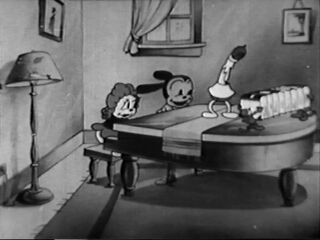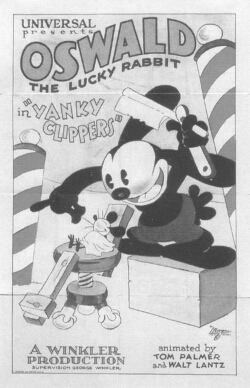
Oswald the Lucky Rabbit is an animated cartoon character created in 1927 by Walt Disney and Ub Iwerks for Universal Pictures. He starred in several animated short films released to theaters from 1927 to 1938. Twenty-seven animated Oswald shorts were produced at the Walt Disney Studio. After Universal took control of Oswald's character in 1928, Disney created a new character similar in appearance to Oswald as a replacement: Mickey Mouse, who went on to become one of the most famous cartoon characters in the world.

Great Guns! is Oswald the Lucky Rabbit cartoon produced by the Walt Disney Studio and Winkler Productions. It was re-issued by Walter Lantz Productions in 1932. It was originally released on October 17, 1927. Great Guns! is a parody of war films, a popular film genre during the silent era.

Tall Timber is a 1928 silent animated short film starring Oswald the Lucky Rabbit and is the 23rd in the series. In terms of production, the film was for many years the last extant Oswald cartoon directed by Walt Disney, until late 2015, when Sleigh Bells, the Oswald cartoon made after Tall Timber, was rediscovered.

Bright Lights is a 1928 silent cartoon short by the Walt Disney Studio and Winkler Productions featuring Oswald the Lucky Rabbit. It is among the few short films of the series Walt Disney himself worked on before leaving that same year.

Mechanical Man is a 1932 cartoon short by Walter Lantz that features Oswald the Lucky Rabbit. It is the 54th Oswald short by Lantz and the 107th in the entire series.

Yanky Clippers is a 1929 silent animated film starring Oswald the Lucky Rabbit. It is among the few shorts created during the Winkler period known to exist. The cartoon is also Oswald's last silent film.

Fiery Firemen is a 1928 silent animated short co-directed by a young Friz Freleng and Rudolf Ising, produced by George Winkler, and stars Oswald the Lucky Rabbit. It is among the few Oswald shorts from the Winkler period known to still exist.
Oil's Well is a 1929 short animated film starring Oswald the Lucky Rabbit and produced by Walter Lantz Productions. It is the 2nd Lantz Oswald film and the 54th in the entire series.

Jungle Jingles is a 1929 animated film produced by Winkler Productions and part of the Oswald the Lucky Rabbit series.

Sick Cylinders is a 1929 animated short film by Winkler Productions which stars Oswald the Lucky Rabbit. It is among the few surviving Oswald films from the Winkler era.

Ham and Eggs is a 1933 animated cartoon produced by Walter Lantz, as part of the Oswald the Lucky Rabbit series. It is the 72nd Oswald short by Lantz and the 124th in the entire series.

The Ginger Bread Boy is a 1934 animated short by Walter Lantz Productions and is among the many films of the Oswald the Lucky Rabbit series. The story mentioned in the cartoon is based on "The Gingerbread Man", published in St. Nicholas Magazine in 1875.

The Hunter is a 1931 short animated film by Walter Lantz Productions and stars Oswald the Lucky Rabbit. It is the 48th Oswald short of the Lantz era and the 100th in the entire series.

Alpine Antics is a 1929 animated cartoon by Winkler Productions and features Oswald the Lucky Rabbit.

Hungry Hoboes is a silent Oswald the Lucky Rabbit cartoon released by Universal Studios in 1928. It had been lost since before World War II and was rediscovered in 2011.
Grandma's Pet is an animated short film by Walter Lantz Productions and is part of the Oswald the Lucky Rabbit series. It is the 53rd Lantz Oswald cartoon and the 106th cartoon overall.

Carnival Capers is a 1932 animated short film featuring Oswald the Lucky Rabbit. It is the 65th Oswald cartoon by Walter Lantz Productions and the 117th in the entire series.

The County Fair, also called The Country Fair in some reissues, is a short animated film distributed by Universal Pictures, in the Oswald the Lucky Rabbit series. The cartoon shares a very similar title with Kounty Fair, another Oswald short released four years prior.
The Candy House is a 1934 short animated film by Walter Lantz Productions featuring Oswald the Lucky Rabbit. The film is an adaptation of the fairy tale Hansel and Gretel by the Brothers Grimm and is one of the few Oswald shorts in which he plays a different character.
Wonderland is a 1931 short animated film by Walter Lantz Productions and part of a long-running short film series featuring Oswald the Lucky Rabbit. Contrary to its title, the film is not an adaptation of Alice in Wonderland but that of Jack and the Beanstalk.
















